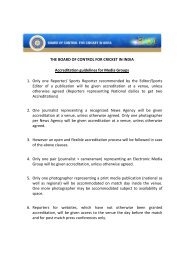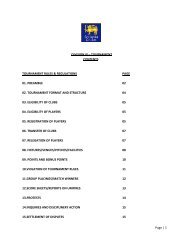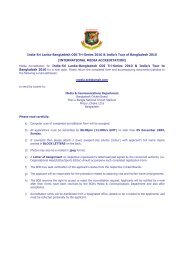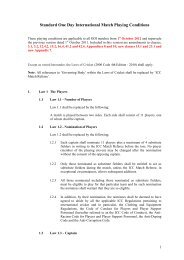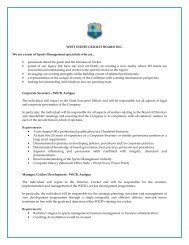Standard ODI Playing Conditions - Sri Lanka Cricket
Standard ODI Playing Conditions - Sri Lanka Cricket
Standard ODI Playing Conditions - Sri Lanka Cricket
You also want an ePaper? Increase the reach of your titles
YUMPU automatically turns print PDFs into web optimized ePapers that Google loves.
04<br />
standard ONE-day INTERNatiONAL<br />
match playing conditions<br />
d) If the third umpire decides the batsman is out a red light is displayed;<br />
a green light means not-out. Should the third umpire be temporarily<br />
unable to respond, a white light (where available) will remain illuminated<br />
throughout the period of interruption to signify to the on-field umpires<br />
that the TV replay system is temporarily unavailable, in which case the<br />
decision will be taken by the on-field umpire. (As an alternative to the red/<br />
green light system and where available, the big replay screen may be used<br />
for the purpose of conveying the third umpire’s decision.)<br />
e) When reviewing the TV replay(s), if the third umpire believes that the<br />
batsman may instead be out by any other mode of dismissal, beyond<br />
that initially consulted upon, he shall initiate the process described<br />
in paragraph 3.3 below as if the batsman has been given not out. This<br />
will not count as a Player Review for the purposes of paragraph 3.5.<br />
2.2 Caught Decisions<br />
I<br />
in the event of an appeal for a caught decision:<br />
a) Clean Catches<br />
i) Should the bowler’s end umpire be unable to decide whether<br />
or not a catch was taken cleanly, he shall first consult with the<br />
square leg umpire.<br />
ii) Should both on-field umpires be unable to make a decision,<br />
they may consult by two-way radio with the third umpire.<br />
Following such consultation, the final decision will be made and<br />
given by the bowler’s end umpire, who will take into account the<br />
on-field umpires’ initial views and any other advice received from<br />
the third umpire.<br />
iii) the third umpire has to determine whether the batsman has<br />
been caught. However, in reviewing the television replay(s), the<br />
third umpire shall first check the fairness of the delivery (fair<br />
delivery – the feet or full toss above waist height) and whether<br />
the batsman has hit the ball. If the delivery was not a fair delivery<br />
or if it is clear to the third umpire that the batsman did not hit<br />
the ball he shall indicate to the on-field umpire that the batsman<br />
is not out caught, and in the case of an unfair delivery, advise the<br />
on-field umpire to signal no ball. See also paragraph 3.10 below.<br />
iv) When reviewing the TV replay(s), if the third umpire believes that<br />
the batsman may instead be out by any other mode of dismissal,<br />
beyond that initially consulted upon, he shall initiate the process<br />
described in paragraph 3.3 below as if the batsman has been<br />
given not out. This will not count as a Player Review for the<br />
purposes of paragraph 3.5.<br />
b) Bump Ball<br />
i) Should the bowler’s end umpire be unable to decide whether a<br />
catch was taken from a bump ball or not, he shall first consult<br />
with the square leg umpire.<br />
ii) Should both on-field umpires be unable to make a decision, the<br />
bowler’s end umpire shall be entitled to refer the decision to the<br />
third umpire to review a TV replay(s) of the batsman’s stroke as in<br />
paragraph 2.1 (b).<br />
iii) the third umpire has to determine whether the ball was a bump<br />
ball or not. However, in reviewing the television replay(s), the third<br />
umpire shall first check the fairness of the delivery (fair delivery –<br />
the feet) and whether the batsman has hit the ball. If the delivery<br />
4.36



